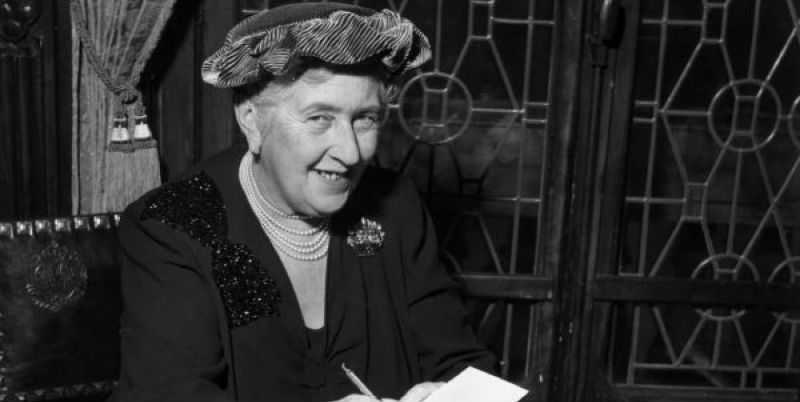Agatha Christie is, of course, one of the most famous writers ever to have written in the English language, or any language for that matter, and is the best-selling fiction writer of all time. I revere her, and have revered her since I was a kid – I’ve probably read every one of her books five times. I’ve always thought, though, that despite the staggering success of her books, she doesn’t get nearly as much credit as she should for the sheer skill of her writing. Her craft is unobtrusive yet dead-on, her word choice simple but perfect, but her real superpower lies in her versatility. She can transport you in the space of a few words to 1960s London or to pre-war Rhodes, and from points of view as varied as that of an elderly spinster (Miss Marple) to a young invalid war hero (The Moving Finger).
Of course, anyone reading this article is familiar with Agatha Christie’s great novels. But I’ve always loved her less-well-known short stories just as much. Many of them don’t involve murder – they involve theft, or mistaken identity, or other crimes of deception, or even just an unhappy marriage. And many of them don’t involve Hercule Poirot or Miss Marple – instead, they involve absolutely delightful characters like Mr. Satterthwaite, Harley Quin, and Mr. Parker Pyne.
But more often than not, her short stories are miniature jewels of character and location study – her characters travel even more in her short stories than they do in her novels – and I find myself coming back to them again and again. And, fascinatingly, often you see themes and strands of plot appear in her short stories that she uses later in full-length novels. Without further ado, please see below a list of my ten favorites. (I should say that I could easily have included forty of her stories on this list of ten!)
10: The Face of Helen
Mr. Satterthwaite is an elderly rich bachelor, an inveterate snob, and a passionate observer of human nature, perhaps because his own life has left him on the sidelines of human drama. Harley Quin is a thin, dark man who “comes and goes,” and whenever he turns up, Mr. Satterthwaite ends up solving a mystery. I can’t recommend the collection “The Mysterious Mr. Quin” highly enough – it transports you directly to the inter-war era of black-tie house parties and winters on the Riviera – but this story is one of my particular favorites. When Mr. Satterthwaite is at the opera one evening, he spies the face of a woman – one of the most beautiful women he has ever seen. He soon gets to know her and learns that two men are vying for her affections – one a pleasant-faced clerk in a shipping firm, the other a dark, brooding artistic type. Mr. Satterthwaite smells danger, but will he find its source before it’s too late? A jewel of a story and a time capsule into an envy-inducing era.
9: The Gate of Baghdad
“Are you happy? If not, consult Mr. Parker Pyne” reads the ad on the front page of the London Times. Mr. Parker Pyne’s cases range from abandoned spouses to bored wealthy women to repentant thieves, and Mr. Parker Pyne Investigates is a great, easy vacation read.
My pick for this list, though, is one of the few Parker Pyne stories that involves murder. Mr. Parker Pyne is going from Damascus to Baghdad, a thirty-six hour trip by “Pullman” covering four hundred miles of desert. Halfway through, the male passengers have to wake up to push the coach, which has gotten stuck in mud. But one of them doesn’t wake up …
Agatha Christie famously spent much of the later part of her life in the Middle East alongside her archaeologist husband, Sir Max Mallowan. Her stories set there are always a particular joy, filled with marvelous detail. The Gate of Baghdad is no exception. Interestingly, it features elements of plot that later figure in her novels They Came to Baghdad and Appointment with Death.
8: Motive v. Opportunity
While Christie wrote many Poirot short stories, her Miss Marple stories are sadly fewer and further between. The Tuesday Night Club is the classic collection. In the first half of the book, six people – Miss Marple herself; her nephew, Raymond; a local artist, Joyce; an ex-Commissioner of Scotland Yard, Sir Henry Clithering; the local clergyman, Dr. Pender; and a solicitor, Mr. Petherick – meet every Tuesday evening to tell the story of an unsolved mystery and to see if the group can come to a solution. To the group’s surprise, Miss Marple outdoes them all every time – “straight to the truth like a homing pigeon,” as Sir Henry Clithering later says.
In Motive v. Opportunity, Mr. Petherick tells the story of a rich elderly man who comes under the influence of sinister spiritual grifters. Against everyone’s wishes, he leaves a will leaving them all his money. But when the envelope is opened later, it contains a blank piece of paper. The title of the story reflects the quandary: Those who had the motive to substitute the piece of paper did not have the opportunity to do so, and those who had the opportunity to do so had no motive. A clever story with a simple, funny solution – and a variation on a theme to which Christie returned on multiple occasions, including in another Miss Marple story, Strange Jest, and a few Poirot ones, too, such as The Case of the Missing Will, The Dream, and Four-and-Twenty Blackbirds.
7: The Adventure of the Christmas Pudding
More a novella than a short story, The Adventure of the Christmas Pudding is a real classic – for the specificity and deliciousness of its setting, for its psychological precision, for the multiple strands of its mystery, each of which gets tied up with a bow like a perfectly-wrapped Christmas gift. Hercule Poirot is persuaded against his will to spend Christmas at a manor house in the countryside, Kings Lacey, to recover a jewel stolen from an Eastern prince by a showgirl. (The key to persuading him? The promise of oil-fired central heating!) But he realizes that other sinister forces may be afoot as well when he receives a note upon his arrival: “DON’T EAT NONE OF THE PLUM PUDDING. ONE AS WISHES YOU WELL.” Peppered with memorable characters, in particular Mrs. Lacey, Kings Lacey’s elderly chatelaine, The Adventure of the Christmas Pudding is sheer pleasure.
6: A Christmas Tragedy
Another Christmas story, but a much darker one this time around. This story, from the back half of The Tuesday Night Club, features perhaps my favorite version of Miss Marple – as the ruthless avenging angel we also see in A Caribbean Mystery and Nemesis. While staying at a hotel for Christmas, Miss Marple spies a young couple ostensibly deeply in love. But what she suspects upon seeing them is far more sinister. A Christmas Story displays all of Christie’s psychological acumen while also providing a good deal of insight into Miss Marple’s own character. After the murderer is eventually caught and hanged, Miss Marple’s comment is, “A good job too. I have never regretted my part in bringing that man to justice. I’ve no patience with modern humanitarian scruples about capital punishment.”
5: The Capture of Cerberus
I could easily have just made this list my top ten stories from The Labours of Hercules, which might actually be my single favorite Agatha Christie book (at least today; this changes frequently). Hercule Poirot decides that he will finally retire but, before he does, he will undertake twelve final cases themed after the Labours of his namesake. Every single story in this collection is a sparkling gem, and it was very difficult to decide which ones to include on this list.
The Capture of Cerberus – Hercules’s last labor – is, of course, the last story in the collection. Poirot comes across his old adversary-slash-flame, the Countess Vera Rossakoff (more about the Countess below), on a tube escalator going in the other direction. When he desperately calls to her to ask where he can find her, she shouts back, “In Hell.”
As it turns out, Hell is an exclusive new nightclub of which the Countess is a part owner. When Poirot starts spending more time there in her company, he begins to suspect that all in Hell is not exactly what it seems. The Capture of Cerberus shines because of its modernity – drugs! Jazz! Late nights! – but also because of its depiction of a world you’d give anything to be a part of, even if just for a night.
4: The Voice in the Dark
This is my personal favorite of the Mr. Satterthwaite and Harley Quin stories. Lady Stranleigh is a marvelously-preserved childhood friend of Mr. Satterthwaite’s, glamorous and four-times married. Mr. Satterthwaite himself describes her as “beautiful, unscrupulous, completely callous, interested solely in herself.” But when her extremely dull and sensible daughter Margery begins hearing voices saying, “Give back what is not yours,” Lady Stranleigh is sufficiently spooked to ask Mr. Satterthwaite to investigate. A fascinating story both in terms of setting and psychology, The Voice in the Dark is also one of the several occasions where Christie imbues a story with a seemingly supernatural twist, only to provide a rational explanation in the end – such as in Poirot’s The Adventure of the Egyptian Tomb or Dumb Witness.
3: The Nemean Lion
The first story in The Labours of Hercules. On the lookout for a case involving a lion, to mirror Hercules’s own first labor, Poirot has dreams of a case involving a figurative lion – even a Prime Minister. He is disappointed and annoyed when the first case that Miss Lemon puts on his desk concerns the disappearance of a Pekinese dog. Poirot is about to reject it when he realizes that there is something about the case that’s interesting after all. And who does his client, Sir Joseph Hoggin, remind him of? Something’s ringing a bell …
An absolutely charming story with well-drawn characters and a satisfying resolution, The Nemean Lion is the perfect start to the wonder that is The Labours of Hercules.
2: The Double Clue
So many of Agatha Christie’s best short stories feature Poirot and Hastings that I can’t believe I’m only including one of them on this list. That said, this one’s a real Duesy. A rich collector, Marcus Hardman, hosts guests in his London flat and shows them priceless jewels from his safe. When his four guests leave, the jewels are missing. But the safe contains two clues – a dropped glove and a silk cigarette case. One clue might make sense, but two clues? It seems that one is genuine and one is planted, but how to tell which is which?
This is Poirot’s first story featuring the Countess Vera Rossakoff, who later featured in The Big Four and in The Capture of Cerberus (above). Another written time-travel machine to the glamorous pre-war era, The Double Clue is witty, evocative, and simple. In fact, I’d go so far as to say that The Double Clue is more or less the perfect Agatha Christie short story, and I really probably should have put it in first place. And yet …
1. The Listerdale Mystery
The genteel but down-on-her-luck Mrs. St. Vincent, a widow, is living with her two children in a boarding house when she comes upon an ad too good to be true – a lovely house at a such a low rent that she assumes it must be a mistake. But it isn’t, and the family soon moves in under the benevolent eye of Quentin, the butler. Her son Rupert soon figures out that the house is the house from which a certain Lord Listerdale had vanished some years earlier and, against Mrs. St. Vincent’s wishes, begins to investigate. Did Quentin kill his master?
Some might be surprised that I’m putting this story in first place – even I have to admit that it’s on the slighter side. But in the end, even among us hard-boiled crime readers and writers, who in their heart of hearts doesn’t hope for a happy ending?
***


















